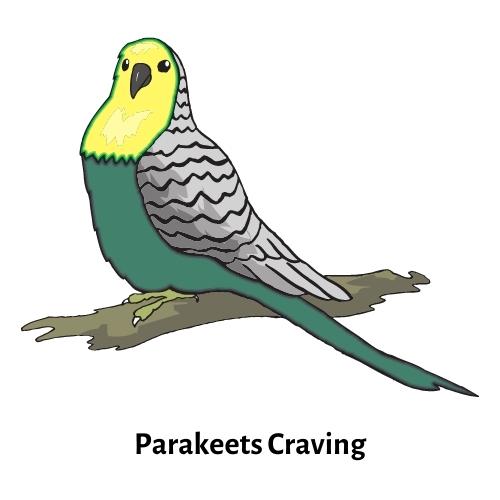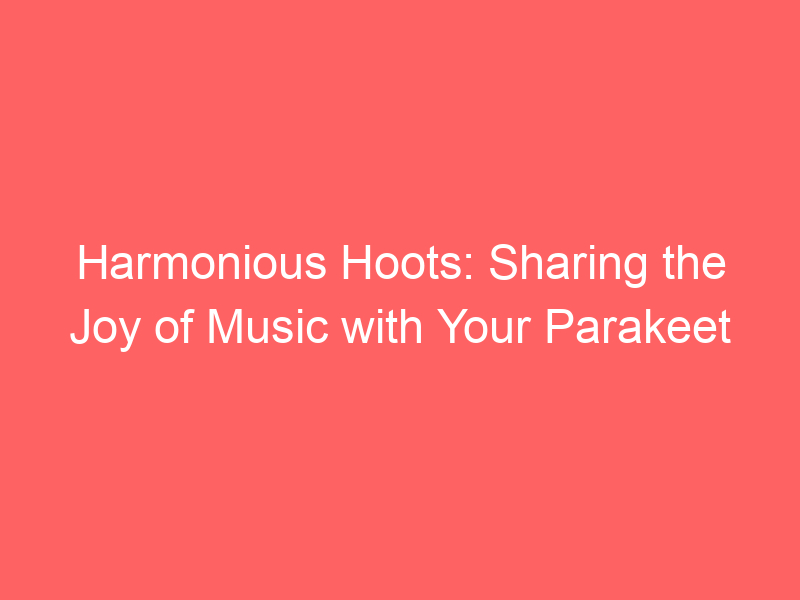
Introduction to Parakeet Music
Music is a universal language that transcends boundaries and species. It’s not just humans who enjoy a good tune; our feathered friends, particularly parakeets, also find joy in music. This article will explore the fascinating world of parakeet music, highlighting the joy of sharing music with your parakeet and understanding the importance of bird-friendly music.
- The joy of sharing music with your parakeet
- Understanding the importance of bird-friendly music
Sharing music with your parakeet can be an incredibly rewarding experience. Parakeets, known for their sociable nature and vocal abilities, often respond positively to music. Playing music can stimulate their minds, keep them entertained, and even strengthen the bond between you and your pet.
Research shows that parakeets can differentiate between different rhythms and melodies, and they often show preferences for certain types of music. Some parakeets may even bob their heads or chirp along to the beat, providing a delightful shared experience for both you and your feathered friend.
While parakeets enjoy music, it’s crucial to ensure that the music is bird-friendly. Not all types of music are suitable for parakeets. Loud, heavy, or fast-paced music can stress them out, while soft, slow, and melodic tunes are more likely to be enjoyed.
It’s also important to remember that parakeets have sensitive hearing. Therefore, the volume should be kept at a comfortable level. By understanding and respecting your parakeet’s musical preferences and sensitivities, you can create a harmonious and enjoyable musical environment for your pet.
In the following sections, we will delve deeper into the world of parakeet sounds, explore the concept of music therapy for parakeets, and discuss how you can enjoy music with pets beyond parakeets. We will also share some fascinating case studies on parakeet music response. So, stay tuned and let’s embark on this melodious journey together!
Understanding Parakeet Sounds
Parakeets, also known as budgies, are known for their vibrant colors and their ability to mimic human speech. But did you know that their sounds are not just mere imitations? They are a form of communication, and understanding these sounds can help you better connect with your feathered friend.
-
Decoding Parakeet Sounds: A Guide
-
How Parakeet Sounds Relate to Music
Parakeets produce a variety of sounds, each with its unique meaning. Here’s a simple guide to help you decode them:
| Sound | Meaning |
|---|---|
| Chirping | Parakeets chirp when they are happy and content. It’s their way of singing. |
| Squawking | A loud squawk can indicate fear or anger. It’s a warning signal. |
| Chattering | When parakeets chatter, they are either talking to themselves or trying to communicate with you. |
Remember, these are general interpretations. Each parakeet is unique and may have its own variations of these sounds.
Parakeets are musical creatures. They have a natural affinity for melody and rhythm. This is why their sounds often seem musical to us.
Research has shown that parakeets, like humans, can perceive pitch, melody, and rhythm. They can even bob their heads in time with the music! This is why many parakeet owners play music for their pets. It stimulates their minds and keeps them happy.
Understanding the musicality of parakeet sounds can help you better appreciate your pet’s vocalizations and even strengthen your bond with them.
So the next time your parakeet chirps, squawks, or chatters, listen closely. They might be trying to tell you something!
Music Therapy for Parakeets
Music therapy is a powerful tool that can greatly benefit our feathered friends, particularly parakeets. This form of therapy can have a profound impact on their overall well-being, from reducing stress to enhancing mood and energy levels.
Benefits of Music Therapy
There are numerous benefits that music therapy can provide for parakeets. Here, we will focus on two major advantages:
- Stress Reduction in Parakeets
Parakeets, like humans, can experience stress. This can be due to a variety of factors such as changes in their environment, lack of social interaction, or health issues. Music therapy can help alleviate this stress. A study conducted by the University of Veterinary Medicine in Vienna found that birds exposed to music showed lower stress levels compared to those who were not. The calming melodies can soothe their nerves and provide a sense of comfort.
- Enhanced Mood and Energy Levels
Music can also uplift the spirits of parakeets. They are known to respond positively to certain types of music, often seen bobbing their heads or even dancing along to the rhythm. This not only boosts their mood but also encourages physical activity, which is essential for their health. In fact, a study from the University of Maryland revealed that birds exposed to music exhibited more active behavior and showed signs of improved mood compared to those who were not.
In conclusion, music therapy can be a wonderful addition to your parakeet’s daily routine. It not only helps in reducing stress but also enhances their mood and energy levels. So, why not try incorporating some melodies into your parakeet’s life and see the positive changes it brings?
How to Implement Music Therapy
Implementing music therapy for your parakeet is a two-step process. It involves choosing the right music and setting up a comfortable music environment. Let’s delve into these steps in more detail.
- Choosing the right music for your parakeet
Parakeets are sensitive creatures, and their response to music can vary greatly. It’s essential to choose the right music that your parakeet will enjoy and benefit from. Here are some tips:
Firstly, consider the tempo of the music. Parakeets generally prefer music with a slow to moderate tempo. Fast-paced music can cause them to become agitated or stressed.
Secondly, the volume of the music matters. It should be soft enough not to startle your bird but loud enough for them to hear clearly. Remember, parakeets have sensitive hearing.
Lastly, choose music with a pleasant melody. Parakeets are known to respond well to music with a clear, melodious tune.
- Setting up a comfortable music environment
Once you’ve chosen the right music, the next step is to create a comfortable music environment for your parakeet. Here’s how:
Ensure the music source is not too close to the bird’s cage. This can prevent the music from being too loud for your parakeet.
Try to play the music at consistent times each day. This can help your parakeet get used to the music and even look forward to it.
Observe your parakeet’s reaction to the music. If they seem distressed or agitated, it may be best to turn the music off and try a different song or volume next time.
Remember, the goal of music therapy is to enhance your parakeet’s mood and reduce stress. By choosing the right music and setting up a comfortable music environment, you can help your parakeet enjoy the benefits of music therapy.
Bird Music Interaction
One of the most fascinating aspects of owning a parakeet is observing their interaction with music. Much like humans, parakeets have their own unique responses to different types of music. Let’s delve into how you can observe your parakeet’s response to music.
Observing Your Parakeet’s Response to Music
Observing your parakeet’s response to music can be a rewarding experience. It’s important to note that each bird is unique and may react differently to various types of music. Here are some signs of enjoyment and understanding negative reactions in parakeets.
- Signs of enjoyment in parakeets
- Understanding negative reactions
When parakeets enjoy the music, they often show it through physical movements and vocalizations. They may bob their heads, tap their feet, or even try to mimic the music. Some parakeets may also display fluffed feathers, which is a sign of relaxation and contentment. If your parakeet is chirping along with the music, it’s a good sign that they are enjoying it.
On the other hand, if your parakeet is showing signs of distress such as screaming, trying to fly away, or hiding in the corner of the cage, it may not like the music. Other signs of discomfort include ruffled feathers, a puffed-up appearance, or a lack of activity. If you notice these signs, it’s best to turn off the music and try a different genre or lower the volume next time.
Remember, observing your parakeet’s response to music is not just about entertainment. It’s also about understanding their preferences and ensuring their comfort. So, pay close attention to their reactions and adjust the music accordingly.
Encouraging Interaction with Music
Music can be a wonderful way to bond with your parakeet and stimulate their mind. Here are some ways to encourage your bird to interact with music.
- Introducing Musical Toys
Just like children, parakeets can be fascinated by toys that make noise. Musical toys for birds are designed to be safe and engaging. They can produce different sounds that mimic the natural calls and songs of birds, providing a fun and interactive experience for your parakeet.
When introducing a new musical toy, start by placing it near the cage. Let your bird observe it from a safe distance. Once they seem comfortable, you can bring the toy closer or even place it inside the cage. Remember, patience is key. It might take some time for your parakeet to start playing with the toy, but once they do, it can be a source of endless entertainment and mental stimulation.
- Creating Musical Moments with Your Bird
Another way to encourage interaction with music is by creating musical moments with your bird. This can be as simple as singing to your parakeet or playing an instrument. If you play a musical instrument, try playing it softly near your bird. You might be surprised at their reaction!
Parakeets are known for their ability to mimic sounds, so your bird might even try to join in with your music. This can be a fun and rewarding experience for both of you. It’s also a great way to strengthen your bond with your bird and provide them with mental stimulation.
Remember, the goal is to make music a positive and enjoyable experience for your parakeet. Always observe their reactions and adjust your approach accordingly. With patience and creativity, you can create a musical environment that your bird will love.
Enjoying Music with Pets: Beyond Parakeets
While parakeets are known for their musical abilities, they are not the only pets that can enjoy music. Other pet birds and even different types of pets can also share in the joy of music. Let’s explore this further.
- Music enjoyment in other pet birds
Parakeets may be the stars of the show when it comes to music, but they are not alone. Other pet birds, such as canaries and cockatiels, also have a keen sense of hearing and can enjoy music. Canaries, for example, are known for their beautiful singing. They often respond to music by singing along, creating a delightful duet.
Cockatiels, on the other hand, are known for their ability to mimic sounds. This means they can pick up on musical notes and reproduce them, adding their own unique twist. So, if you play an instrument or enjoy singing, your cockatiel might just join in!
- Sharing musical moments with other pets
But it’s not just birds that can enjoy music. Other pets, such as dogs and cats, can also share in the musical experience. Studies have shown that certain types of music can have a calming effect on dogs. Classical music, for instance, can help reduce stress and anxiety in dogs. So, playing some Mozart or Beethoven might just help your furry friend relax.
Cats, on the other hand, may not respond to human music in the same way. But that doesn’t mean they can’t enjoy music. Researchers have created music specifically designed for cats, using frequencies and tempos that mimic the sounds of purring and birds chirping. When played this music, many cats show signs of relaxation and enjoyment.
So, whether you have a parakeet, a canary, a cockatiel, a dog, or a cat, sharing musical moments with your pet can be a wonderful and enriching experience for both of you.
Case Studies: Parakeet Music Response
Let’s delve into some real-life examples to understand how music impacts parakeets. We will explore two case studies that highlight the transformative power of music therapy on these delightful birds.
- Case study 1: A parakeet’s transformation with music therapy
- Case study 2: The impact of bird-friendly music on a parakeet’s behavior
Meet Charlie, a two-year-old parakeet who was initially shy and reserved. His owner, a music therapist, decided to use music as a tool to help Charlie come out of his shell. She started playing soft, soothing tunes for an hour every day. After a month, a noticeable change was observed in Charlie’s behavior. He became more active, started chirping more, and even began to mimic the tunes. This case study clearly shows how music therapy can positively influence a parakeet’s behavior and mood.
In our second case, we have Bella, a parakeet who was known for her aggressive behavior. Her owner decided to play bird-friendly music, specifically designed with sounds and frequencies that appeal to birds. After a few weeks of consistent exposure to this music, Bella’s aggressive behavior significantly reduced. She started interacting more with her owner and even started dancing to the music. This case study demonstrates the potential of bird-friendly music in modulating a parakeet’s behavior.
These case studies provide compelling evidence of the positive effects of music on parakeets. They highlight the potential of music therapy as a tool for enhancing the well-being and behavior of these charming birds.
Conclusion: The Joy of Music and Parakeets
As we wrap up this enlightening journey into the world of parakeets and music, let’s take a moment to reflect on the key insights we’ve gathered. We’ve seen how music can have a profound impact on these delightful birds, enhancing their well-being and enriching their lives in ways we never thought possible.
- Recap of the benefits of music for parakeets:
- Encouraging pet owners to explore music with their parakeets:
Music has been shown to have a calming effect on parakeets, reducing stress and promoting overall health. It can stimulate their minds, keeping them engaged and active. In some cases, music has even been found to encourage vocalization in parakeets, enhancing their communication abilities. The case studies we’ve explored have provided compelling evidence of these benefits.
As pet owners, we have a unique opportunity to enrich the lives of our parakeets through music. Whether it’s playing soft melodies to soothe them or upbeat tunes to stimulate their minds, the possibilities are endless. Remember, the key is to observe your parakeet’s response and adjust the music accordingly. It’s a journey of discovery that can deepen your bond with your feathered friend.
Music and parakeets – it’s a beautiful symphony that brings joy not just to our pets, but to us as well. So, let’s turn up the volume and let the music play. After all, a world filled with music is a world filled with joy.













